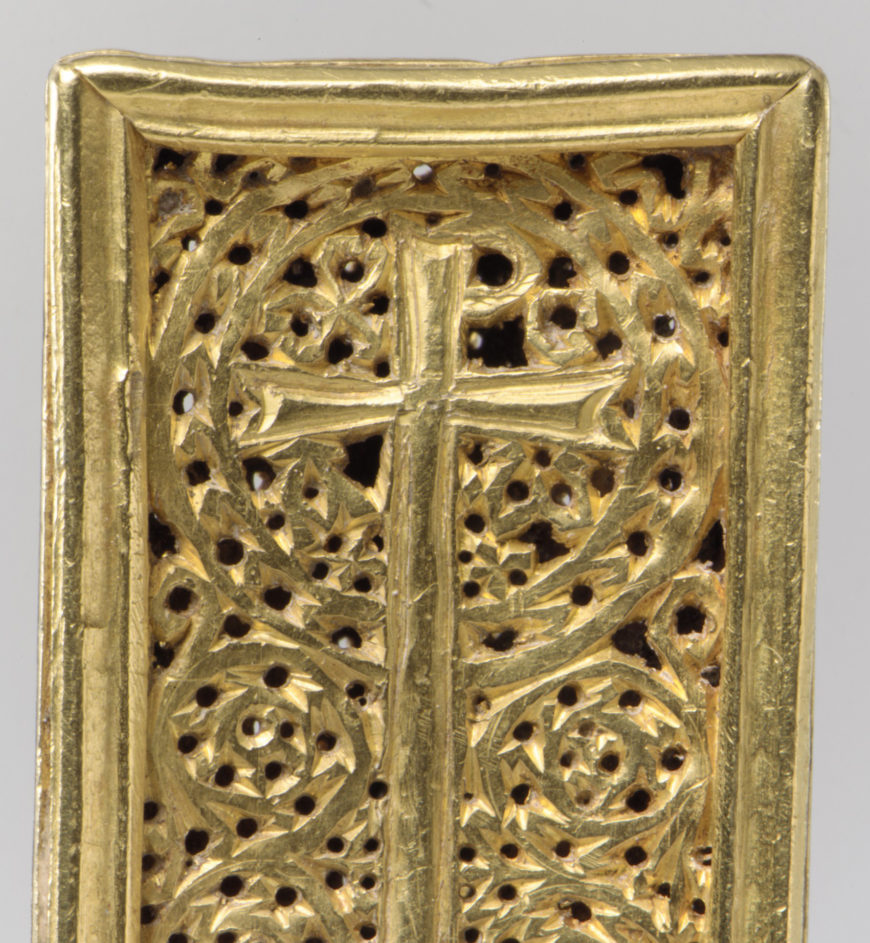
Detail, Byzantine Crossbow Brooch (Fibula), c. 430, made in Rome or Constantinople, gold, 11.9 x 5.5 x 4 cm (The Metropolitan Museum of Art)
Medieval jewelry
Fibulae (singular: fibula) are brooches that were made popular by Roman soldiers, who wore them to hold a cloak or cape in place. Bow fibulae all consist of a body, a pin, and a catch—like safety pins. As a historian of the medieval period writes,
A German archaeologist, Herbert Kuhn, first called the bow fibula an early medieval artifact par excellence. Textbooks and art history studies use it to illustrate sections dedicated to the Dark Ages. There are probably thousands and hundreds of thousands of bow fibulae in European museum collections. A still greater number of specimens come out of archaeological excavations and their incredible diversity defies any attempts to establish unequivocal typologies. [1]
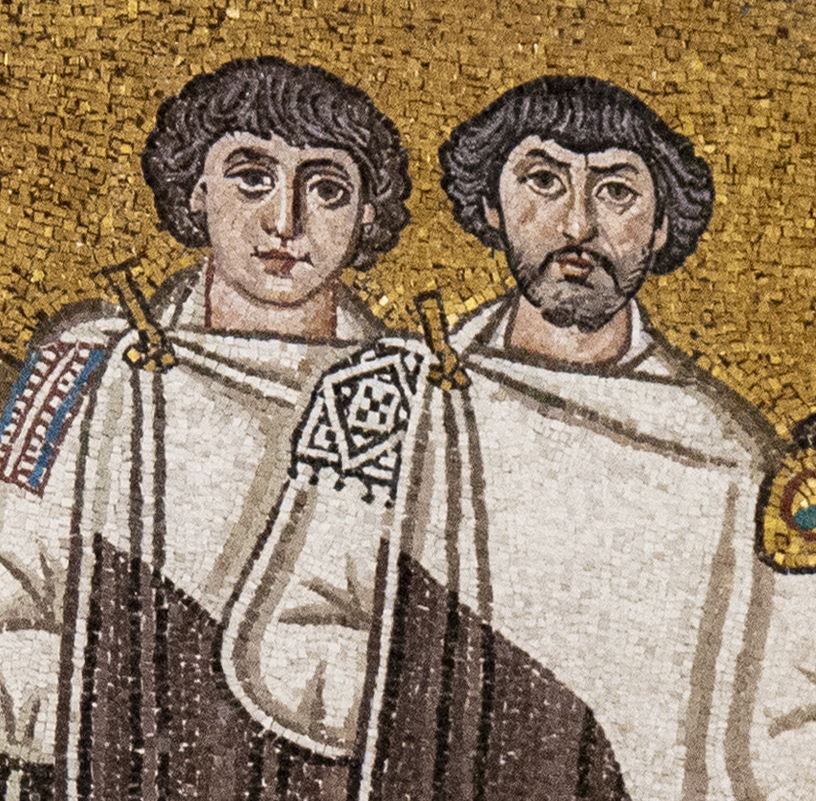
Attendants wearing fibulae, Emperor Justinian Mosaic (detail), San Vitale, Ravenna (Byzantine), c. 546–56 C.E. (photo: byzantologist, CC BY-NC-SA 2.0)
Ornate fibulae became all the rage in the early middle ages (c. 500–800 C.E.), and are one of the most commonly found objects in barbarian grave sites. The word “barbarian” comes from the Greek word barbaros, meaning “foreign,” so it is often used as a blanket term for the non-Roman groups who migrated into western Europe in the early middle ages (such as the Ostrogoths, Visigoths, Franks, and Lombards). This was the time when Europe was becoming Christianized and the Roman Empire split apart. The Roman Empire ceased to exist in the west, but continued in the east as the Byzantine Empire, with its capital at Constantinople (modern-day Istanbul).
This period is also sometimes referred to as the Migration Period. Sparse written documentation of these people survives, so grave goods like fibulae provide the most concrete cultural information available.
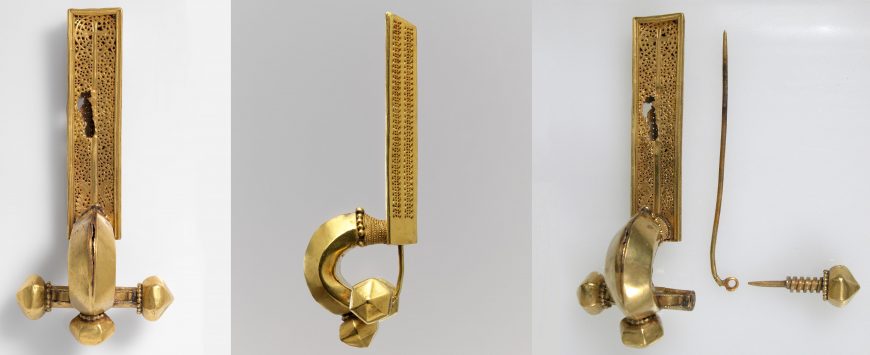
Three views of a Crossbow Brooch, c. 430, made in Rome or Constantinople, gold, 11.9 x 5.5 x 4 cm (The Metropolitan Museum of Art)
Byzantine fibula
This gold fibula was made in Rome or Constantinople in the 5th century and is called a crossbow fibula because of its resemblance to the weapon. Unscrewing the left knob at the end of this “crossbow” would release the pin. This intricate object is typical of the Byzantine/Roman fibulae style. The detailed incising on the body is called pierced openwork.
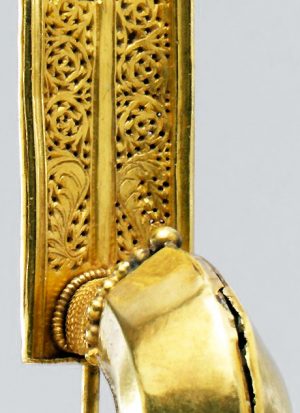
Crossbow Brooch (detail with floral motif emerging from what may be acanthus leaves), c. 430, made in Rome or Constantinople, gold, 11.9 x 5.5 x 4 cm (The Metropolitan Museum of Art)
At the top we see a cross, and below that, on either side, floral scrolls that appear to grow out of acanthus leaves and may symbolize paradise and the promise of salvation. In addition, the circular form around the cross is a victory wreath, which, in the Christian tradition, symbolizes victory over death (resurrection). One art historian has remarked that the brooch “evokes one of the most interesting epochs in antiquity, a period marked by the subtle, often elusive transition from Late Roman to Early Byzantine art.”[2]
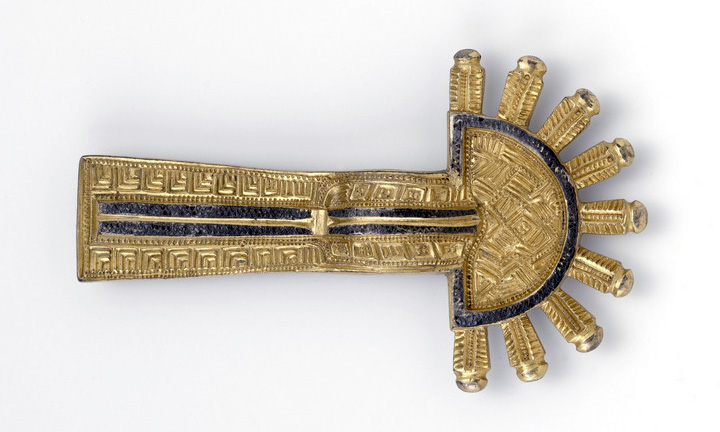
Lombard silver bow fibula, gilded, with inlaid niello and engraved decoration, mid 6th century C.E., found in Kranj, 11.3 cm. long (National Museum, Slovenia)
Lombardic Fibula
This Lombardic fibula found in Kranj (modern day Slovenia) provides a good comparison, because it is a stylized variation of the crossbow fibula. It features at one end a semi-circle from which radiate nine rectangular incised forms topped with spheres (this type of fibula is called “radiate-headed” or “digitated”). It is gilded and inlaid with niello, a black metal alloy. The incisions are hatched lines—a popular decoration technique in Lombardic fibulae.
The Lombards (or Langobards, from the Latin Langobardi) are thought to be of Germanic origin, although their background is still contested. They established their kingdom in Italy in 558 and were defeated by Charlemagne, king of the Franks, in 774. Over the centuries the Lombards assimilated into Roman culture, adopting Christianity, and left their own administrative legal procedures behind. This piece shows the adoption of the crossbow fibula style, but with a small Lombardic “twist.” According to one historian, “everything points to the conclusion that ‘Slavic’ bow fibulae were not simply symbols of social status or gender, but badges of power. This was the power of those able to establish long-distance relations and thus to yield influence.” [3]
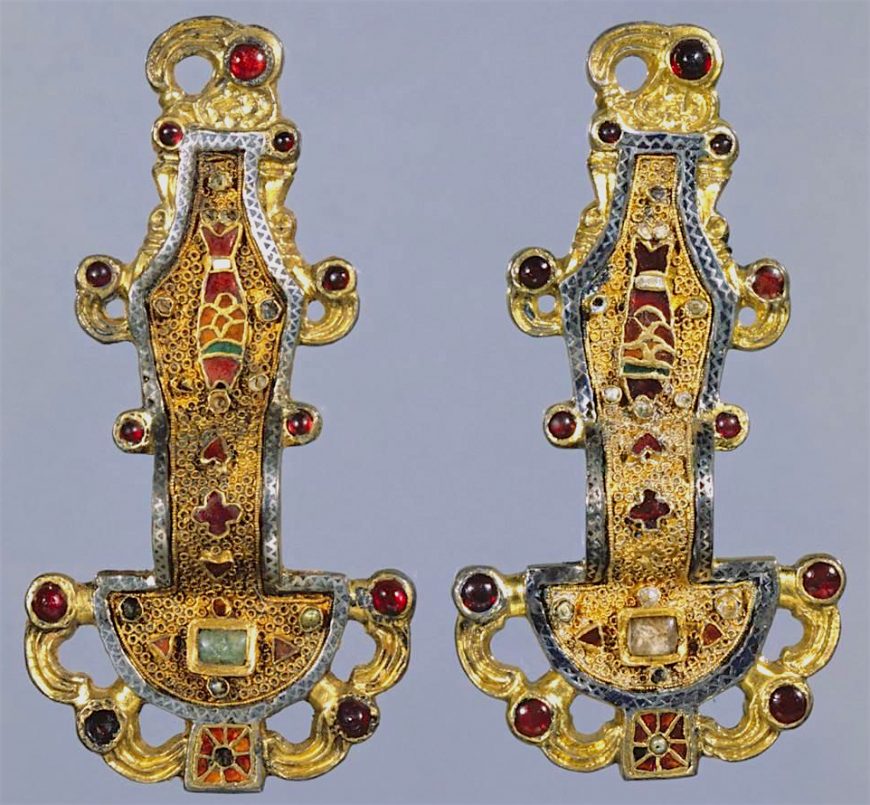
Merovingian (Frankish) Looped Fibulae, mid-6th century, silver gilt worked in filigree with inlaid garnet and other stones (Musée d’Archéologie Nationale, Saint-Germain-en-Laye)
Frankish fibulae
This pair of Merovingian fibulae is a good example of cloisonné, a technique that was popular in barbarian art. This technique is characterized by inlaid semi-precious stones. The word cloisonné literally means “partitioned” in French. The artisan would solder wires onto a metal base and fill the areas created with polished stones (this is different from cloisonné enamel, which has colored enamel baked within these partitions).
This example also shows a popular motif in barbarian art of the middle ages—eagles. The eagle was a symbol of the Roman empire and was adopted at this time because it still carried connotations of status and power. The top end of these fibulae are in the shape of eagle heads and a series of similarly stylized eagle heads can be seen creating the loops on the opposite end of each pin and on the sides. A small fish decorates the main body of each of the brooches. Garnets were used for the eyes of the eagles, and a wide range of gems were used in the rest of the fibulae. These stunning objects demonstrate the remarkable skill of barbarian metal workers during the early middle ages.
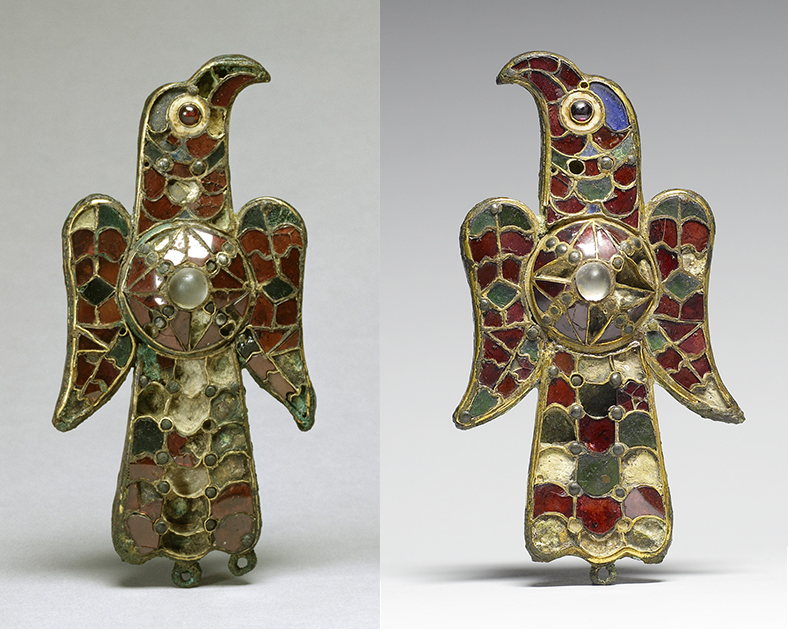
Visigothic Eagle Fibulae, found at Tierra de Barros (Badajoz, southwest Spain), 6th century, sheet gold over bronze inlaid with garnets, amythysts, and colored glass, 14.2 x 7.1 x 3.2 cm (The Walters Art Museum)
Visigothic fibulae
This pair of Visigothic fibulae in the form of eagles provide another good example of barbarian metalwork and cloisonné. They are decorated with garnets, amethyst, and colored glass and were found at a Visigothic grave site in Spain. They likely would have fastened a cloak at the shoulders and pendants may have hung from the loops at the bottom.
Notes:
[1] Florin Curta, The Making of the Slavs: History and Archaeology of the Lower Danube Region, c. 500–700 (Cambridge University Press, reissue edition, 2007), p. 247.
[2] Barbara Deppert-Lippitz, “A Late Antique Crossbow Fibula in The Metropolitan Museum of Art,” Metropolitan Museum Journal, vol. 35, p. 41.
[3] Curta (2007), p. 274.
Additional resources
Katharine Reynolds Brown, Dafydd Kidd, and Charles T. Little, editors, From Attila to Charlemagne: Arts of the Early Medieval Period in The Metropolitan Museum of Art (New York: The Metropolitan Museum of Art, 2000).
Florin Curta, The Making of the Slavs: History and Archaeology of the Lower Danube Region, c. 500–700 (Cambridge University Press, reissue edition, 2007).
Pete Dandridge, “Idiomatic and Mainstream: The Technical Vocabulary of a Late Roman Crossbow Fibula,” Metropolitan Museum Journal, volume 35 (2000).
Barbara Deppert-Lippitz, “A Late Antique Crossbow Fibula in The Metropolitan Museum of Art,” Metropolitan Museum Journal, volume 35 (2000), pp. 39–70.
Smarthistory images for teaching and learning:
[flickr_tags user_id=”82032880@N00″ tags=”Fibula,”]

